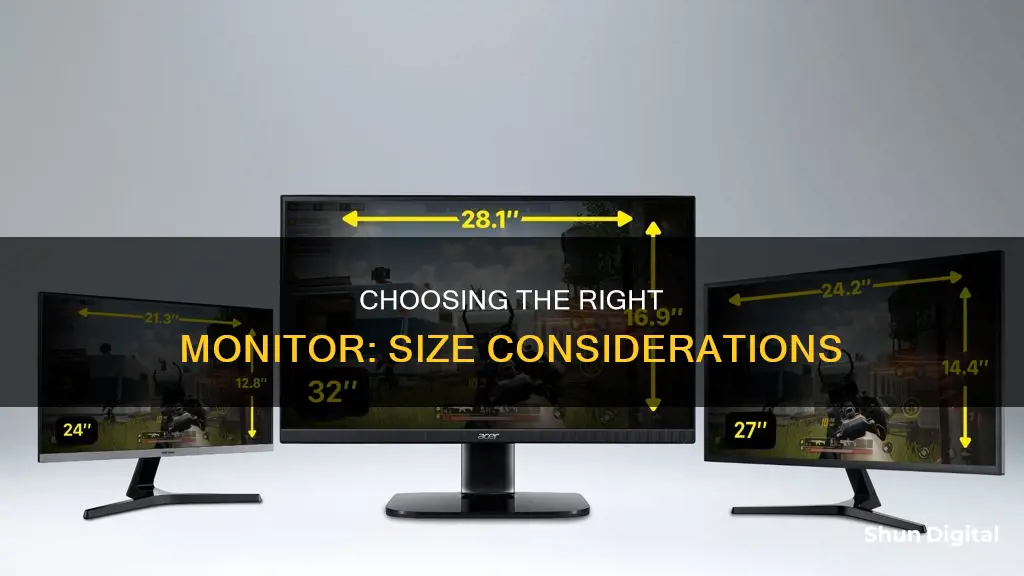
When it comes to choosing a monitor, size is a crucial factor. The market offers a wide range of options, from standard flat screens to ultra-wide displays, catering to diverse needs such as gaming, editing, or everyday tasks like browsing the web and using Microsoft Office applications. The size of the monitor you choose will depend on factors such as your intended use, available space, and budget.
For those seeking a balance between screen real estate and desk space, 24-inch monitors have long been considered the baseline, offering a compromise between size and cost. However, with advancements in technology, larger screens, such as 27-inch and 32-inch monitors, are becoming increasingly popular. These larger options provide more screen space, enabling users to work with multiple windows simultaneously and take advantage of modern resolutions and colour capabilities.
On the other hand, if desk space is limited, opting for a smaller monitor like a 24-inch or even a 22-inch screen might be more suitable. Additionally, for competitive gamers, smaller monitors in the 24-25 inch range are ideal as they offer high refresh rates and 1080p resolution without being too demanding on graphics cards.
For those seeking an immersive experience, ultra-wide monitors, typically with a 21:9 aspect ratio, provide a broader field of view. These monitors are especially popular among gamers and content creators, offering a seamless display that enhances the overall experience.
In conclusion, the best monitor size depends on individual needs and preferences. Whether you're a gamer, a content creator, or a casual user, understanding the available options and considering factors such as space, budget, and intended use will help you choose the right monitor size to maximise your viewing experience.
| Characteristics | Values |
|---|---|
| Monitor size | 24-25 inches, 27 inches, 32 inches, 34 inches, 49 inches |
| Resolution | 1080p, 1440p, 4K, 5K, 8K, 16K |
| Refresh rate | 60Hz, 75Hz, 120Hz, 144Hz, 240Hz, 500Hz |
| Response time | 2ms, 5ms, 10ms, 12ms, 16ms |
| Aspect ratio | 5:4, 16:9, 16:10, 21:9, 32:9, 3:2 |
| Brightness | 250 nits, 350 nits, 300-350 nits, 700 nits, 1000 nits |
| Panel type | TN, IPS, VA, OLED, QLED, Mini LED |
| Ports | HDMI, DisplayPort, USB-C, VGA, DVI |
What You'll Learn
- inch monitors are ideal for gaming and competitive esports
- inch monitors are popular for their balance between size and resolution
- inch monitors are good for gaming and content consumption
- inch ultrawide monitors are great for immersive gaming
- inch super-ultrawide monitors are an alternative to a dual or triple monitor setup

24-25-inch monitors are ideal for gaming and competitive esports
Gaming monitors in this size range tend to have low resolutions and high refresh rates, making them ideal for competitive gaming. They also have low input lag and VRR support, but you also have to consider their response time so that motion is sharp.
The best 25-inch monitor we've tested is the Dell Alienware AW2523HF. It's a versatile monitor that has gaming-focused features, like its fast 360Hz refresh rate that's ideal for competitive gaming. While its 1080p resolution may seem low and doesn't deliver the sharpest detail, this is to be expected for something in this size range, and the low resolution requires less bandwidth on your graphics card, making it easier to maintain high frame rates.
If you're looking for a budget option, the ViewSonic XG2431 is also a great choice. It has a lower 240Hz refresh rate than the Dell but is still high enough for most gamers. It provides impressive gaming performance and has a fast response time, so motion looks crisp with minimal blur.
If you're looking for a cheap display, check out the AOC 24G15N. It has a 24-inch, 1080p display with a lower 180Hz refresh rate, which is still fine for most gamers with entry-level setups. The main downside is that it has noticeable smearing and motion blur with fast-moving objects, which is disappointing for playing fast-paced games.
For those who need something mainly for working, the Dell P2423D is a good option. It has a higher 1440p resolution than the Dell Alienware AW2523HF, resulting in higher pixel density and sharper text clarity. This is useful if you need to read documents or browse the web all day. It comes with an extremely ergonomic stand, making it easy to adjust, and its wide viewing angles help if you need to share the screen with someone next to you.
Signs Your Data is Being Monitored: What to Look For
You may want to see also

27-inch monitors are popular for their balance between size and resolution
27-inch monitors are a popular choice for those seeking a balance between size and resolution. This size offers a happy medium in terms of screen real estate, providing ample space for modern resolutions and colour capabilities without being too big or too small.
A 27-inch monitor is large enough to look impressive on a typical home office desk, but not excessive. It strikes a good balance between size and resolution, allowing users to make the most of modern resolutions and colour capabilities. This size is also ideal for those who want more screen space than a 24-inch monitor but find that a 32-inch or larger screen is too big.
A 27-inch monitor is also a good choice for gamers, as it provides a wider field of view and a more immersive gaming experience without being too big to keep track of all the elements on the screen. Additionally, 27-inch monitors are available in a range of resolutions, from basic 1080p displays to high-resolution 4K screens, making them suitable for various uses, including photo/video editing, gaming, and everyday tasks such as web browsing or document work.
The popularity of 27-inch monitors is also reflected in their availability, with many options on the market to choose from. This includes models with advanced features such as high refresh rates, making them suitable for competitive gaming, and USB-C connectivity, which allows for a single-cable connection to modern laptops.
Overall, a 27-inch monitor offers a good balance of size and resolution, making it a versatile choice for a range of users, from gamers to professionals, without being too big or too small.
Hooking Up a Subwoofer to Bose Desktop Speakers
You may want to see also

32-inch monitors are good for gaming and content consumption
32-inch monitors are a great choice for gaming and content consumption. They offer a more immersive viewing experience than smaller monitors, and their larger size means you can see more of the game or video at once. This can be especially beneficial for immersive single-player games or watching movies. The larger screen size can also be advantageous when using a controller, as it allows you to sit back and relax in your chair without feeling like the screen is too small or distant.
When it comes to resolution, 1440p is often considered the sweet spot for 32-inch monitors. It offers a good balance between picture clarity and screen size, providing a sharp and detailed image without being too demanding on your graphics card. While some people may recommend 4K for a 32-inch monitor, it can be a bit overkill unless you have a very high-end system. Additionally, 1440p allows for higher refresh rates than 4K, which can be beneficial for gaming if your PC can handle it.
One potential downside of 32-inch monitors is that they may feel too big for some people, especially those who sit close to their screens. In competitive first-person shooter games, for example, some players may find it overwhelming to keep track of all the action on a large screen. However, this can be mitigated by adjusting your seating position or moving the monitor further back on your desk.
Overall, 32-inch monitors offer a great balance of screen size and resolution, making them a good choice for gaming and content consumption. They provide a more immersive experience without being too extreme, and the 1440p resolution is ideal for most users. So if you're looking for a monitor that offers a great viewing experience without breaking the bank, a 32-inch monitor with a 1440p resolution could be the perfect choice for you.
Monitoring Device Usage: Securing Your Home WiFi
You may want to see also

34-inch ultrawide monitors are great for immersive gaming
When it comes to choosing a monitor, the most important trait is its size. 24-inch monitors have long been the baseline, but nowadays, 27-inch monitors are the most suitable for most people. However, if you're looking for an immersive gaming experience, 34-inch ultrawide monitors are a great option.
Ultrawide monitors are useful for immersive gaming as they allow you to see more of your surroundings in games than standard 16:9 monitors. Most ultrawide gaming monitors have a 21:9 aspect ratio with a 34-inch screen, but some have larger 49-inch super ultrawide displays with a 32:9 aspect ratio.
The best ultrawide gaming monitor currently on the market is the Dell Alienware AW3423DWF. It has a 34-inch screen with an 1800R curve that helps bring the edges closer to your field of vision, especially if you're sitting close to the monitor. The monitor has a near-instantaneous response time for incredible motion handling, so there's virtually no visible blur behind fast-moving objects. It also has a 165Hz refresh rate for a smooth and responsive feel.
The Dell Alienware AW3423DWF uses a QD-OLED panel, providing exceptional picture quality. It displays deep blacks next to bright highlights in dark rooms, with vivid and life-like colours. This makes it an ideal choice for playing HDR games as highlights also pop. It also supports native FreeSync VRR to reduce screen tearing and is G-SYNC compatible.
If you're looking for a monitor that's more responsive and looks better in a bright room, the LG 34GS95QE-B is a great option. It has a 34-inch, 1440p screen, and a more aggressive 800R curve, so the edges are really brought closer to your field of vision. It has a higher 240Hz refresh rate and the same near-instantaneous response time as the Dell Alienware AW3423DWF, so it's a better choice for competitive gaming.
The LG 34GP83A-B is another good option if you're looking for a 34-inch ultrawide monitor. It has a lower 160Hz refresh rate, but it's still good enough for most gaming situations. It also has an LED-backlit IPS panel, so it can't display deep blacks in a dark room. However, it displays a wide range of colours in HDR, though they don't look as vivid as on the LG 34GS95QE-B.
The Dell S3422DWG is a great budget option for a 34-inch ultrawide gaming monitor. It has a 144Hz refresh rate and a similar performance to the LG 34GP83A-B, but it has more smearing with fast-moving objects. It also has a backlight strobing feature to reduce persistence blur and delivers better picture quality, particularly for HDR gaming.
Overall, 34-inch ultrawide monitors are a great choice for immersive gaming, offering a wider field of view and a more immersive gaming experience.
Simple Ways to Check if Your Monitor is 1080p
You may want to see also

49-inch super-ultrawide monitors are an alternative to a dual or triple monitor setup
49-inch super-ultrawide monitors are a great alternative to a dual or triple monitor setup. They offer a seamless desktop experience with a unique curvature and a wide 32:9 aspect ratio, giving you a lot of space to fit several windows.
The 49-inch super-ultrawide monitor is the equivalent of placing two 27-inch, 1440p monitors side by side, but without the bezels in the middle. This setup is perfect for multitasking and getting work done. For example, large spreadsheets will appear less cramped, which is ideal for professionals who need to analyze large amounts of information.
The super-ultrawide monitor is also an excellent choice for gaming, offering an incredibly immersive gaming experience for racing games, flight simulators, and RTS titles. However, they aren't as widely compatible with games or videos that are not suitable for such a ratio.
When it comes to features, the 49-inch super-ultrawide monitor offers a range of options. Most models offer a resolution of 5120x1440 pixels, but 3840x1080 pixels models are also available. Some monitors in this category also support a 240Hz refresh rate and an impressive low latency of 0.03ms response time. Additionally, some models include built-in apps, allowing you to use the monitor as a command center for your smart home or as an entertainment center.
In terms of connectivity, while USB-C ports are not standard on all models, most 49-inch super-ultrawide monitors offer multiple video inputs, such as DisplayPort and HDMI. Some models also include a USB hub with multiple USB-A and USB-C ports, making it easy to connect multiple devices.
When considering a 49-inch super-ultrawide monitor, it's important to keep in mind that they require a significant amount of desk space due to their large size and curved design. Additionally, while some models offer built-in speakers, the audio quality may not be as impressive as a dedicated speaker setup.
Overall, the 49-inch super-ultrawide monitor is a great alternative to a dual or triple monitor setup, offering a seamless and immersive experience for both work and play.
Monitoring Water Usage: Can You Track and Save?
You may want to see also
Frequently asked questions
The size of the monitor you buy depends on your preferences, the amount of space you have, and your budget. 24-25 inch monitors are ideal if you don't have a lot of desk space and want to see everything within your field of vision. 27-inch monitors are the most popular, offering anything from basic 1080p displays to high-resolution 4K screens. 32-inch monitors are also a good option if you want more screen space but find that even larger screens are too big. If you want an immersive gaming experience, you can opt for a 34-inch ultrawide monitor or a 49-inch super-ultrawide monitor.
For work tasks and general home admin, a 27-inch monitor or smaller is recommended. If you work in video editing or other creative roles that require more screen space, a larger monitor, such as a 32-inch or 34-inch ultrawide monitor, may be more suitable.
For multimedia professionals such as photographers, graphic designers, and video production artists, a larger screen with a resolution of at least Full HD or Quad HD is recommended. This provides more screen space and highly detailed images. A monitor with an IPS panel is ideal for this purpose as it offers deep blacks, accurate colors, and wide viewing angles. Additionally, if you are editing movies and videos, look for a monitor with a response time of 5ms or less to reduce motion blur and ghosting.







